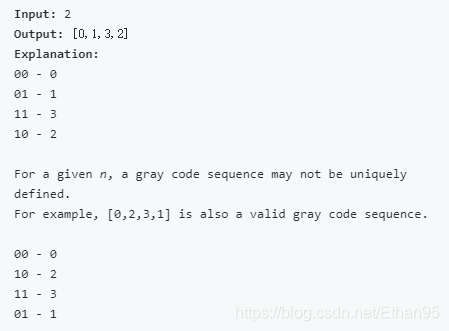【LeetCode】89. Gray Code(C++)
阿新 • • 發佈:2018-12-19
地址:https://leetcode.com/problems/gray-code/
題目:
The gray code is a binary numeral system where two successive values differ in only one bit.
Given a non-negative integer representing the total number of bits in the code, print the sequence of gray code. A gray code sequence must begin with 0.
Example 1:

Example 2:

理解:
有點像permutation,想到用backtracking求解,但是具體實現還是有些不太一樣吧,下面是我的實現,但是並不能跑出來正確的結果。
實現:
class Solution {
public:
vector<int> grayCode(int n) {
vector<string> res;
string tmp(n, '0');
dfs(res, tmp, 0, n);
vector<int> intRes(pow(2,n),0);
for (int i = 這樣應該是不行的,改成1以後就改不回來了,不能滿足gray碼的特點。是不是可以多用一個數組去記錄是第幾次訪問?但是好像也不太好實現。參考下別人的方法,其中flip這個操作,會先把0變成1,當第二次再呼叫的時候會把1再變回0。
class Solution {
public:
vector<int> grayCode(int n) {
bitset<32> bits;
vector<int> res;
backtracking(bits, res, n);
return res;
}
private:
void backtracking(bitset<32>& bits, vector<int>& res, int k) {
if (k == 0) {
res.push_back(bits.to_ulong());
return;
}
backtracking(bits, res, k - 1);
bits.flip(k - 1);
backtracking(bits, res, k - 1);
}
};
實現2:
還可以用非遞迴的方法,利用gray碼的特點,長為n的格雷碼,就是長為n-1的前面加0和長為n-1的逆序排列,在前面加1。
class Solution {
public:
vector<int> grayCode(int n) {
vector<int> res(1, 0);
for (int i = 0; i < n; ++i) {
int preCnt = res.size();
int tmp = (1 << i);
while (preCnt) {
res.push_back(tmp + res[preCnt - 1]);
--preCnt;
}
}
return res;
}
};
